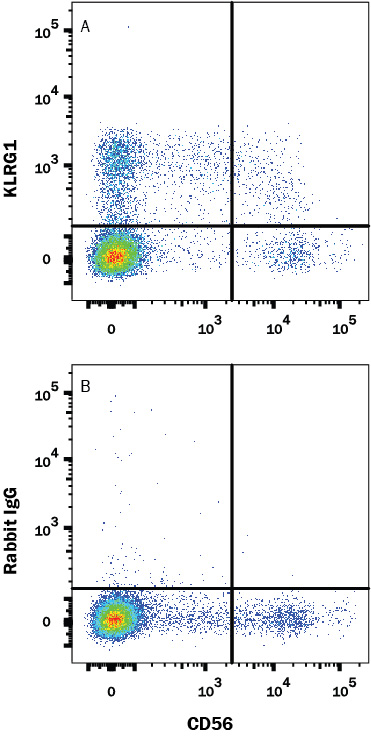Human KLRG1 Antibody Summary
Leu60-Phe195
Accession # Q96E93
Applications
Please Note: Optimal dilutions should be determined by each laboratory for each application. General Protocols are available in the Technical Information section on our website.
Scientific Data
 View Larger
View Larger
Detection of KLRG1 in Human Peripheral Blood by Flow Cytometry. Human peripheral blood was stained with (A) Rabbit anti-Human KLRG1 Monoclonal Antibody (Catalog # MAB70293) or (B) Rabbit IgG control antibody (Catalog # MAB1050) followed by APC-conjugated Anti-Rabbit IgG Secondary Antibody (Catalog # F0111) and CD56 PE-conjugated Monoclonal Antibody (Catalog # FAB2408P). View our protocol for Staining Membrane-associated Proteins.
 View Larger
View Larger
KLRG1 in Human Tonsil. KLRG1 was detected in immersion fixed paraffin-embedded sections of human tonsil using Rabbit Anti-Human KLRG1 Monoclonal Antibody (Catalog # MAB70293) at 3 µg/mL for 1 hour at room temperature followed by incubation with the Anti-Rabbit IgG VisUCyte™ HRP Polymer Antibody (Catalog # VC003). Before incubation with the primary antibody, tissue was subjected to heat-induced epitope retrieval using Antigen Retrieval Reagent-Basic (Catalog # CTS013). Tissue was stained using DAB (brown) and counterstained with hematoxylin (blue). Specific staining was localized to cytoplasm in lymphocytes. View our protocol for IHC Staining with VisUCyte HRP Polymer Detection Reagents.
Reconstitution Calculator
Preparation and Storage
- 12 months from date of receipt, -20 to -70 °C as supplied.
- 1 month, 2 to 8 °C under sterile conditions after reconstitution.
- 6 months, -20 to -70 °C under sterile conditions after reconstitution.
Background: KLRG1
KLRG1 (killer cell lectin-like receptor G1), also called MAFA (mast cell function associated), is a 30-38 kDa type II transmembrane inhibitory glycoprotein of the C‑type lectin family, designated CLEC15A. KLRG1 cDNA encodes 195 amino acids (aa) including an intracellular ITIM motif and a 136 aa extracellular domain (ECD) with a single C‑type lectin domain. The human KLRG1 ECD shares 57% and 54% aa identity with mouse and rat KLRG1, respectively. A 189 aa isoform diverges at aa 186. KLRG1 binds E-, N- and R-cadherins and functions as an MHC‑independent means of identifying non-self pathogens and epithelial tumor cells with low E‑cadherin expression. It is expressed as a monomer or disulfide‑linked homodimer on NK and T cell subsets such as tumor-infiltrating lymphocytes.
Product Datasheets
Citation for Human KLRG1 Antibody
R&D Systems personnel manually curate a database that contains references using R&D Systems products. The data collected includes not only links to publications in PubMed, but also provides information about sample types, species, and experimental conditions.
1 Citation: Showing 1 - 1
-
Neurodegeneration by alpha-synuclein-specific T cells in AAV-A53T-alpha-synuclein Parkinson's disease mice
Authors: AA Karikari, RL McFleder, E Ribechini, R Blum, V Bruttel, S Knorr, M Gehmeyr, J Volkmann, JM Brotchie, F Ahsan, B Haack, CM Monoranu, U Keber, R Yeghiazary, A Pagenstech, T Heckel, T Bischler, J Wischhusen, JB Koprich, MB Lutz, CW Ip
Brain, Behavior, and Immunity, 2022-01-12;101(0):194-210.
Species: Human
Sample Types: Whole Tissue
Applications: IHC
FAQs
No product specific FAQs exist for this product, however you may
View all Antibody FAQsReviews for Human KLRG1 Antibody
There are currently no reviews for this product. Be the first to review Human KLRG1 Antibody and earn rewards!
Have you used Human KLRG1 Antibody?
Submit a review and receive an Amazon gift card.
$25/€18/£15/$25CAN/¥75 Yuan/¥2500 Yen for a review with an image
$10/€7/£6/$10 CAD/¥70 Yuan/¥1110 Yen for a review without an image


